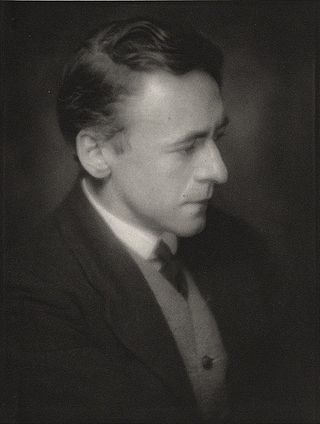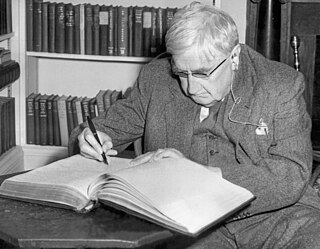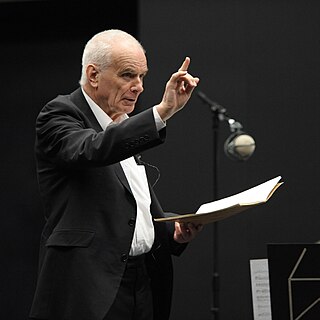Background
The work was complete in piano score shortly before the First World War, and orchestrated in 1916. It was premiered by the Chicago Symphony Orchestra conducted by Frederick Stock on 29 October 1920, [1] and first performed in Britain on 11 December 1920 by the British Symphony Orchestra, conducted by Adrian Boult. [2]
Bax was a great admirer of Celtic culture, including Irish myths, in which the garden of Fand is the sea. The old saga The Sick-bed of Cuchulain tells of a hero, Cuchulain, who is seduced away from home and duty by the Lady Fand, wife of Manannan, lord of the ocean. Cuchulain's wife, Emer, pursues him and persuades Fand to release him. Manannan shakes his "Cloak of Forgetfulness" between Cuchulain and Fand, and each forgets the other completely. [1] Bax did not depict the original story in his symphonic poem, but painted a picture of a ship, cast ashore on Fand's enchanted island. The crew are drawn into Fand's eternal world of dancing and feasting, as the rising sea overwhelms the island, and the garden of Fand is lost from sight. [3]
In a preface to the score states that “The Garden of Fand is the sea” and sets out the legend of Cuchulain, before noting “this tone-poem has no special relation to the events of the above legend”. [4] The composer described the work to his partner, Harriet Cohen, as "the last of my Irish music". [1]
Music
The work is in ternary form, with the music of the opening returning at the end, with Fand's love-song in between. The opening is a shimmering theme played by woodwind, two harps and divided upper strings, with the lower strings playing a rising and falling theme illustrative of the swell of the sea. Fand's song, in the central section, is played by flute and cor anglais in unison, over strings divided into ten parts. [5] Bax's orchestration is on his customary lavish scale. A reviewer in the US after the work was first played there, remarked on the score's "singular poetic intensity, singular eloquence and beauty", although adding that Bax "is, of course, a child of his time, and he cannot forget Debussy". [3] The musical scholar Andrew Keener also notes the Debussian influence: "there is the characteristic writing in parallel thirds that move by whole tones, and brass and woodwind detail which glints out of a surging, opulent orchestral sonority". [5]
Orchestral forces required are three flutes and piccolo, two oboes and cor anglais, three clarinets and bass clarinet, two bassoons and contra bassoon; four horns, three trumpets, trombone and tuba; timpani, glockenspiel, cymbal, bass drum, celesta; two harps and strings. [4]
Fand or Fann is an otherworldly woman in Irish mythology. The two forms of her name are not phonetic variants, but two different words of different meaning and the history of her name is debated.

Sir Arnold Edward Trevor Bax was an English composer, poet, and author. His prolific output includes songs, choral music, chamber pieces, and solo piano works, but he is best known for his orchestral music. In addition to a series of symphonic poems, he wrote seven symphonies and was for a time widely regarded as the leading British symphonist.
Ralph Vaughan Williams dedicated his Symphony No. 4 in F minor to Arnold Bax.
A London Symphony is the second symphony that Ralph Vaughan Williams composed. The work is sometimes referred to as Symphony No. 2, though the composer did not designate that name for the work. First performed in 1914, the original score of this four-movement symphony was lost and subsequently reconstructed. Vaughan Williams continued revisions of the work into its final definitive form, which was published in 1936.
Sinfonia antartica is the Italian title given by Ralph Vaughan Williams to his seventh symphony, first performed in 1953. It drew on incidental music the composer had written for the 1948 film Scott of the Antarctic.
Ralph Vaughan Williams composed his Symphony in E minor, published as Symphony No. 6, in 1944–47, during and immediately after World War II and revised in 1950. Dedicated to Michael Mullinar, it was first performed, in its original version, by Sir Adrian Boult and the BBC Symphony Orchestra on 21 April 1948. Within a year it had received some 100 performances, including the U.S. premiere by the Boston Symphony Orchestra under Serge Koussevitzky on 7 August 1948. Leopold Stokowski gave the first New York performances the following January with the New York Philharmonic and immediately recorded it, declaring that "this is music that will take its place with the greatest creations of the masters." However, Vaughan Williams, very nervous about this symphony, threatened several times to tear up the draft. At the same time, his programme note for the first performance took a defiantly flippant tone.

Ralph Vaughan Williams's Symphony No. 8 in D minor was composed between 1953 and 1955. Sir John Barbirolli, its dedicatee, conducted the Hallé Orchestra in the premiere at the Kings Hall in Manchester, on 2 May 1956. It is the shortest of the composer's nine symphonies, and is mostly buoyant and optimistic in tone.

The Bard, Op. 64, tone poem for orchestra written in 1913 by the Finnish composer Jean Sibelius. It was first performed in Helsinki on 27 March 1913 by the Philharmonic Society Orchestra, conducted by the composer himself, but he revised it in 1914. The new version was first performed in Helsinki on 9 January 1916, again under the baton of the composer.

Tintagel is a symphonic poem by Arnold Bax. It is his best-known work, and was for some years the only piece by which the composer was known to many concert-goers. The work was inspired by a visit Bax made to Tintagel Castle in Cornwall in 1917, and, although not explicitly programmatic, draws on the history and mythology associated with the castle.
The Overture to a Picaresque Comedy is a concert overture composed by Arnold Bax in 1930. It was premiered by the Hallé Orchestra conducted by the dedicatee, Sir Hamilton Harty, in November 1931. The work is untypical of its composer, who was not usually associated with comedy in music.
The Symphony No. 2 in E minor and C major by Arnold Bax was completed in 1926, after he had worked on it for two years. It was dedicated to Serge Koussevitzky, who conducted the first two performances of the work on 13 and 14 December 1929.
The Symphony No. 6 by Arnold Bax was completed on February 10, 1935. The symphony is dedicated to Sir Adrian Boult. It is, according to David Parlett, "[Bax's] own favourite and widely regarded as his greatest ... powerful and tightly controlled". It was given its world premiere by the Royal Philharmonic on November 21 of the year of composition, 1935.
The Symphony No. 3 by Arnold Bax was completed in 1929. It was dedicated to Sir Henry Wood and is perhaps the most performed and most immediately approachable of Bax's symphonies.
November Woods is a tone poem by Arnold Bax, written in 1917. Ostensibly a musical depiction of nature, the work conveys something of the composer's turbulent emotional state arising from the disintegration of his marriage and his love affair with the pianist Harriet Cohen. According to the composer, the piece is not programmatic, but evokes mood rather than painting a picture or telling a story.
The Symphony No. 1 Elevamini is an orchestral work by Australian-born composer Malcolm Williamson.

The Symphony No. 5 was composed by Peter Maxwell Davies in 1994 on commission from the Philharmonia Orchestra, who gave the world premiere under the composer's direction at a BBC Promenade concert on 9 August 1994 at the Royal Albert Hall in London.

John Alfred Terence MacDonagh was an English oboist and cor anglais player, particularly known as one of the four members of the Royal Philharmonic Orchestra's so-called "Royal Family" of woodwind players.
The Symphony No. 6, From a New Zealand Diary, Op. 65, is an orchestral composition by the Finnish composer Aulis Sallinen, who wrote the piece from 1989–90. The New Zealand Symphony Orchestra, the commissioning institution, premiered the work on 6 September 1990 in Napier, under the baton of Sallinen's longtime advocate, Okko Kamu. Sallinen and his wife had vacationed in New Zealand the year prior, providing the composer with inspiration for the symphony, which—though properly symphonic in scope and in structure—has been described as involving "tone painting"; indeed, each of the four movements contains a descriptive title, unusual for a Sallinen symphony.
A Fugal Overture, Op. 40/1, H 151, is a short concert overture for full orchestra by the English composer Gustav Holst. It was written in 1922 and first performed in 1923, and is a very early example of musical neoclassicism. Though there were conflicting opinions from Holst's contemporaries about the work's merits, it has since come to be considered an attractive and exciting, if slight, example of Holst's later style.





